RVing to Alaska - The Plan
Alaska was one of the very first destinations we knew we wanted to visit when we started planning our RV adventure. We took a cruise through the inside passage for our honeymoon, and we’ve wanted to return to explore inland ever since. We did not feel confident enough in the RV or our abilities to make it our first destination, but after a year on the road, I think we’re as ready as we can be for it.
Despite the title of the post, we don’t actually have that much of a plan for the trip. We have a few major sights we know we’ll hit, and we have a few set dates for family visits and the Xscapers convergence, but the rest is up in the air. One thing we’ve learned in our first year is that fixed dates and plans almost always add more stress than they’re worth. Being flexible means we can move with the weather, leave early or stay extra depending on how much we like a stop, and add new stops on the fly.
All of that said, here’s a quick rundown of how the trip is shaping up so far.
Timeline
Overall, the trip will last about 4 months.
The plan was to cross the border into Canada sometime between May 15th (the earliest most people recommend going) and June 1st. Since I’m a bit delayed, I can tell you that we actually crossed on May 22nd.
Will’s family is meeting us at Denali National Park on June 26th, so we need to be there by then. The drive to Alaska should only take about 2 weeks at a reasonable pace. We’ll have plenty of wiggle room to stop and rest or sightsee along the way.
We’d really like to see the Northern Lights, so that’s what we’re using as our end point before heading home. We could get lucky, but most likely, we’ll have to wait until sometime in September to have a good shot at seeing them. We’ll wait until we see the Northern Lights, snow starts falling, and then we’ll head south.
The Route to Alaska
Border Crossing
There are a few common crossing locations. If you’re in Washington, you can cross near Vancouver or Osoyoos, stay west-ish, and head north to Prince George, British Columbia. If you’re in Idaho or Montana, you cross near Glacier National Park and head through the Canadian Rockies.
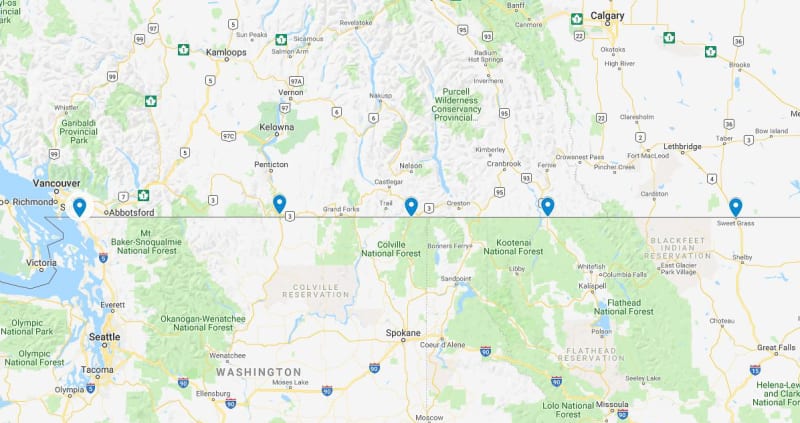
Common border crossing locations when RVing to Alaska
We definitely want to start in the Canadian Rockies. There are four Canadian National Parks there: Kootenay, Banff, Yoho, and Jasper. There’s also the Icefields Parkway which connects Banff and Jasper and is considered one of the most scenic drives on the planet. We do not want to miss that.
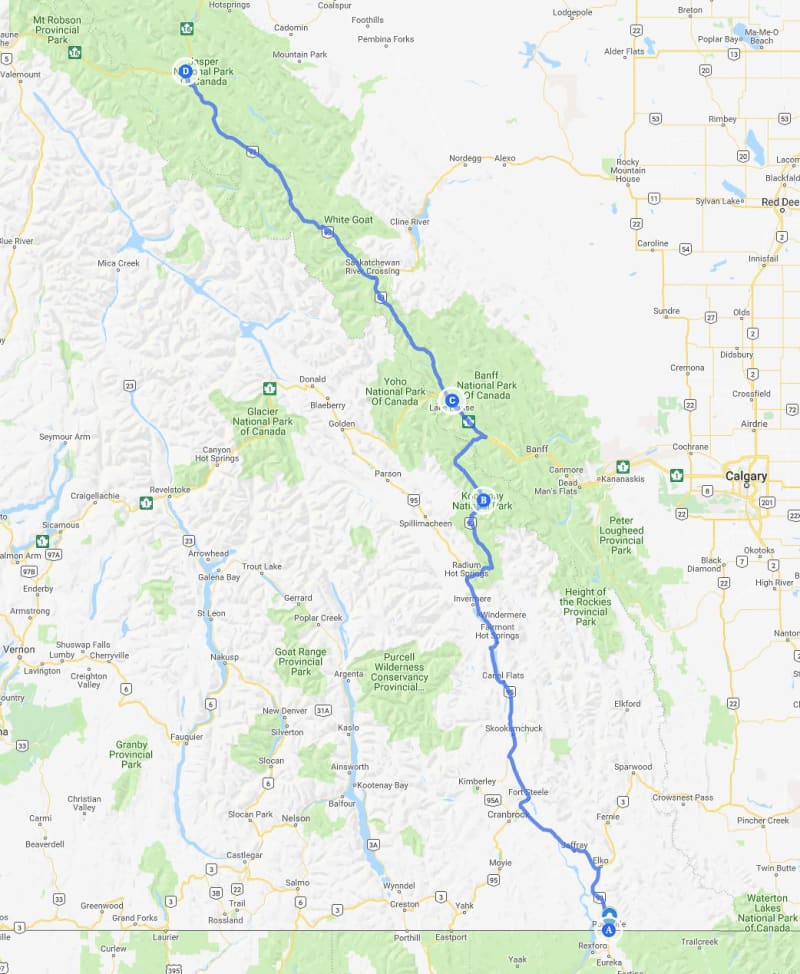
Our route through the Canadian Rockies
Alaskan Highway versus the Cassiar
After traveling through the southern part of the Canadian Rockies, we’ll have the option to head west to Prince George or north to Dawson Creek. From Prince George, we could stay west-ish and take the Cassiar Highway to Watson Lake in the Yukon Territory. This route is supposed to be beautiful, and there are some good side trips along the way; however, the major downside is that there’s essentially no cell phone coverage along the entire route. We could rush it over a long weekend and get by without interfering with Sushila’s work, but we don’t really want to do that. We might take this route back to the States, though.
The other option is to start in Dawson Creek, British Columbia, and follow the Alaskan Highway (aka the Alcan). This is the route we plan to take. Cell reception probably won’t be amazing here, either, but there will be more reasonably-sized towns to pass through where we’ll be able to get connected. We’ll have less pressure to rush through this part of the trip, and of course, there is still plenty to see and do along the route.
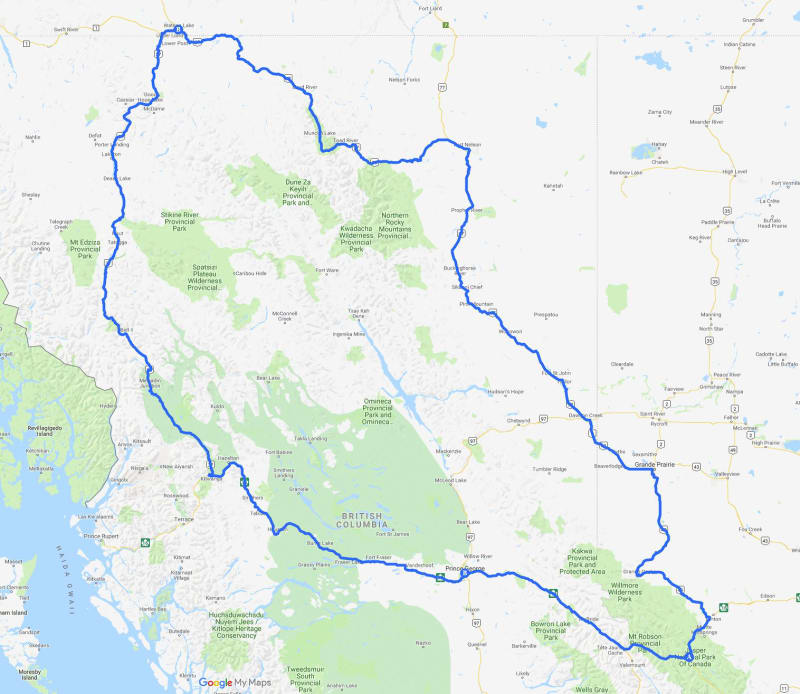
The Cassiar stays further west and the Alaskan Highway is further east
Top of the World or Alaskan Highway
Both of the previous routes converge near Watson Lake, Yukon, and follow the Alaskan Highway to Whitehorse, Yukon. From there, we’ll have another choice: go north to Dawson City and cross into Alaska via Top of the World Highway or stay south and cross via the Alaskan Highway.
Right now, we’re leaning toward staying on the Alaskan Highway the whole way in. It’s shorter and the roads should be more well maintained. I think the cell reception will be a bit better, too. We’ve heard from multiple people that Top of the World Highway was one of the highlights of their trip, though, so we might change our mind on this. We’ll see how we’re feeling when we get to Whitehorse. If we don’t do it on the way up, we will still have the option to do it on the way back.
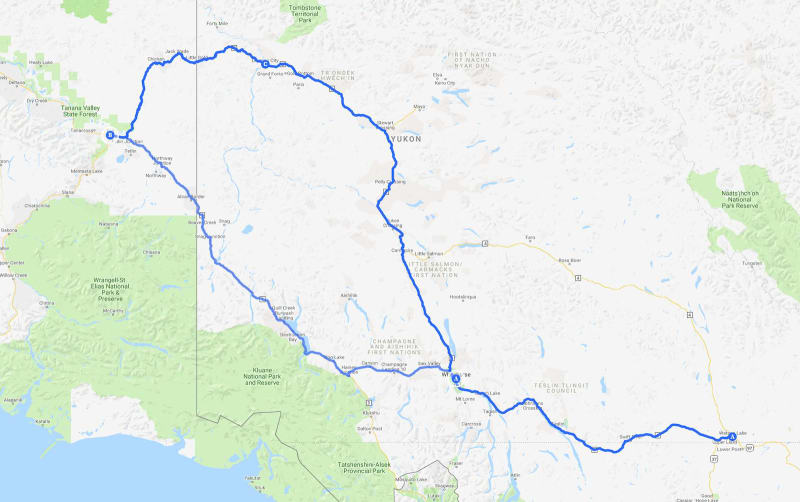
We go North from Whitehorse for the Top of the World Highway or West along the Alaskan Highway
Alaska
Once we’re in Alaska, it’s basically just a big circle connecting Anchorage and Fairbanks.
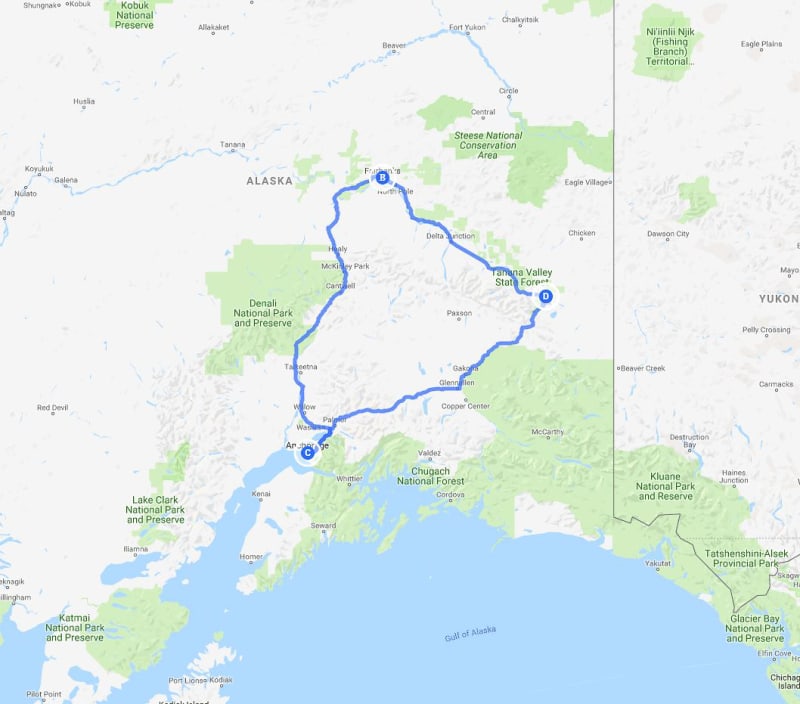
The main route around Alaska
We’ll follow that loop one way or the other and stop to see the sights along the way.
Fixed Dates
We have three fixed dates that we’re working around for the trip:
- Will’s parents visit: June 26 - July 4
- Sushila’s mom visits: July 6 - 13
- Xscapers Convergence: July 18 - 22
We have some plans with the families, and we’ll be in Isabell Pass for the convergence, but otherwise we don’t have any fixed schedule. We do have some ideas for places we want to go and things we want to see, though.
National Parks
There are eight (8!) national parks in Alaska. That’s a lot.
- Denali
- Glacier Bay
- Wrangell-St. Elias
- Kenai Fjords
- Lake Clark
- Katmai
- Gates of the Arctic
- Kobuk Valley
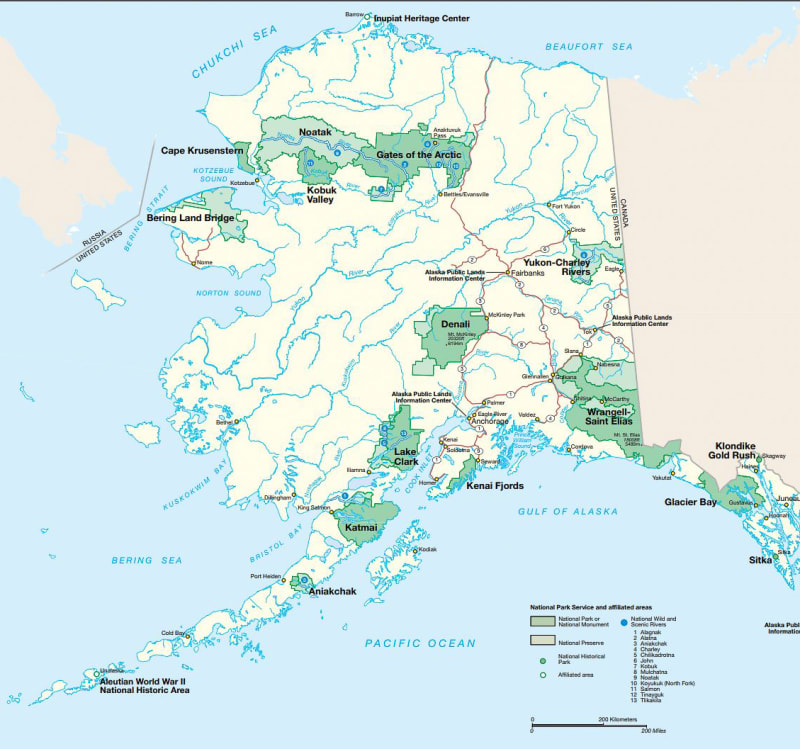
Alaska’s National Parks. Photo Credit: www.alaska.org
We visited Glacier Bay on our honeymoon cruise through the inside passage, so we don’t feel strongly that we need to get back there. I would like to visit Skagway, though, which is pretty close, so who knows. Maybe we’ll end up visiting again.
Originally, we hoped to visit the remaining 7 parks on this trip; however, only Denali, Kenai Fjords, and Wrangell-St. Elias are accessible by driving. The remaining 4 require a charter flight. After checking out the costs for those flights, we decided to scale back our plans and just visit 1 of the 4 instead.
Of the four, we decided to visit Lake Clark National Park. It’s the closest to Anchorage, so the flights are a bit cheaper; however, the main draw is visiting Dick Proenneke’s cabin on Twin Lakes. He’s the subject of the self-filmed documentary Alone in the Wilderness. At age 52, he moved to Alaska and built his own cabin on the remote lake. He ended up living there for over 30 years and only left when his health declined. When he left, he donated the cabin to the National Park Service, and visitors can still see it today.
Other Ideas
There is plenty to do in Alaska besides visiting National Parks. We haven’t ironed out the details yet, but we know the Kenai Penninsula (just southwest of Anchorage) is supposed to be wonderful, so we’d like to spend at least a week or two out there.
We will spend some time around Fairbanks, the second largest city in Alaska and northernmost metropolitan area in the United States. We’ve heard that Valdez is a must-see, and McCarthy is supposed to be worth a visit, too. There are many other small towns along the main roads around the state, and I’m sure we’ll stop in some of them, too.
I would also like to see the Arctic Ocean while we’re in Alaska. Sushila isn’t completely sold yet, but hopefully we’ll get there. Originally, we were considering driving up the Dalton Highway to Prudhoe Bay, an oil field along the Arctic Ocean that allows visitors. It’s a very long drive, though, and it’s not RV-friendly, so we’d have to leave it and the cats behind. We’re now considering trying to fly to Barrow (aka Utqiagvik) instead. Flights there aren’t too expensive, and it would be a much easier trip. We’ll see how we’re feeling when we get to that point in the trip, though.
RV Preparation
While doing online prep, I found some people traveling to Alaska will add serious upgrades to their RV prior to the trip. I was a little nervous at first that we’d need to do the same, but after talking with some others who’ve made the trip, it didn’t seem necessary. That said, we did do some general maintenance and improvements that will hopefully keep things going smoothly on the trip.
To start, we had all of the tires inspected (thanks Discount Tire), and they look good. No more uneven wear on the trailer (yet, anyway - we’re measuring regularly to catch it earlier if it happens again). We had a truck wheel that was cracked and (very) slowly leaking, so we finally replaced that wheel. We also got new tires for both spares since we didn’t replace them when we originally replaced the other tires on the vehicles.
We follow the maintenance schedule for our truck pretty closely, but we made sure to take it in for a check up just before we left. We replaced some fluids, but otherwise everything looked good. Belts and brakes were checked a few months ago, and they are good to go, too.
We did a pretty thorough inspection of the trailer’s suspension when we discovered uneven tire wear a few months ago, and the rubber shear springs in the equalizer looked pretty rough. We replaced those about a month ago, and we also replaced some of the bushings in the leaf springs which were pretty well shot. Bearings were repacked, and everything is freshly-greased.
We did have the leaf spring supports reinforced. They’re a common point of failure, and a lot of people recommend doing it, so we probably would have done it anyway. Knowing we were going to Alaska, we decided to get it done now. We also had the hitch receiver upgraded from 1” to 2” on our trailer. We keep our bikes back there, and all the bouncing around can’t be great for the bike rack. The new receiver is much sturdier and moves significantly less. The bike rack still appears to be in good condition, but we check it pretty regularly. If we ever spot cracks or anything like that, we can now upgrade to a heavier duty 2” bike rack.
The only interior upgrade we made was adding the sliding drawers for our new pantry. Like most of the other prep, it was something we would have done anyway, but since we wanted to be able to stock up and carry more food while traveling through Alaska, we pushed to get it done before the trip.
Onward
If you’re following along on Facebook or Instagram, you’ll know that we’re already a week into the trip. So far, things have been going well. We already extended a stay by one day to give ourselves good weather for the Icefields Parkway, and I’m glad we could do it without needing to worry about changing reservations.
We’ll see how the rest of the trip goes, but I’m feeling pretty confident that our current planning strategy will work out well.
